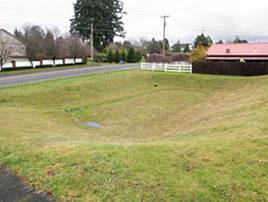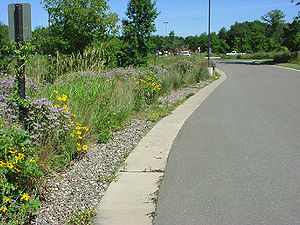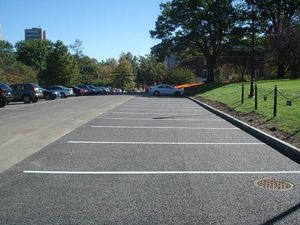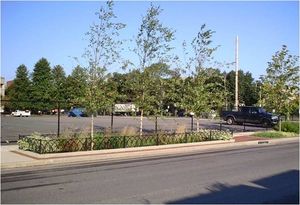
Difference between revisions of "BMPs for stormwater infiltration"
m |
m |
||
| Line 265: | Line 265: | ||
*[[References for permeable pavement]] | *[[References for permeable pavement]] | ||
*[[Requirements, recommendations and information for using permeable pavement BMPs in the MIDS calculator]] | *[[Requirements, recommendations and information for using permeable pavement BMPs in the MIDS calculator]] | ||
| + | |||
| + | ==Tree box/Tree trench== | ||
| + | [[file:Tree box photo 1.jpg|left|300px|thumb|alt=photo of tree box|<font size>Tree box (Source: CDM Smith)</font size>]] | ||
| + | |||
| + | {| class="wikitable" style="float:right; margin-left: 10px; width:500px;" | ||
| + | |- | ||
| + | | colspan="4" style="text-align: center;"| '''Applications and treatment capabilities for tree box/tree trench''' | ||
| + | |- | ||
| + | | colspan="2" style="text-align: center;" | '''Applications''' | ||
| + | | colspan="2" style="text-align: center;" | '''Treatment capabilities<sup>2, 3, 4</sup>''' | ||
| + | |- | ||
| + | | Residential | ||
| + | | yes | ||
| + | | TSS | ||
| + | | High | ||
| + | |- | ||
| + | | Commercial | ||
| + | | Yes | ||
| + | | TN | ||
| + | | Low/Medium<sup>5</sup> | ||
| + | |- | ||
| + | | Ultra-urban | ||
| + | | Yes | ||
| + | | TP | ||
| + | | Medium/High | ||
| + | |- | ||
| + | | Industrial | ||
| + | | Yes<sup>1</sup> | ||
| + | | Chloride | ||
| + | | Low | ||
| + | |- | ||
| + | | Highway/road | ||
| + | | No | ||
| + | | Metals | ||
| + | | High | ||
| + | |- | ||
| + | | Recreational | ||
| + | | Yes | ||
| + | | Oils and grease | ||
| + | | High | ||
| + | |- | ||
| + | | | ||
| + | | | ||
| + | | Pathogens | ||
| + | | High | ||
| + | |- | ||
| + | | colspan="4" style="text-align: center;" | <font size=1><sup>1</sup> Unless the infiltration practice is located in an industrial area with exposed significant materials or from vehicle fuelling and maintenance areas. Infiltration BMPs are PROHIBITED in these areas; <sup>2</sup> This is only for the portion of flow that enters the infiltration basin; by-passed runoff does not receive treatment; <sup>3</sup> Low = < 30%; Medium = 30-65%; High = 65 -100%); <sup>4</sup> Assumes adequate pre-treatment; <sup>5</sup> Insufficient information<br> | ||
| + | Source: see [http://stormwater.pca.state.mn.us/index.php/File:Trees_Tasks_2_and_13_Water_quality_benefits.docx] | ||
| + | </font size> | ||
| + | |} | ||
| + | |||
| + | Tree trenches and tree boxes (collectively called tree BMPs), consist of trees planted within underground storage reservoirs designed to retain a volume of runoff for the purpose of uptake by trees. They are a variant of bioretention BMPs. For more information, see the following pages in this Manual. | ||
| + | :'''Trees - general''' | ||
| + | *[[Overview for trees]] | ||
| + | *[[Types of tree BMPs]] | ||
| + | *[[Plant lists for trees]] | ||
| + | *[[Street sweeping for trees]] | ||
| + | *[[References for trees]] | ||
| + | *[[Supporting material for trees]] | ||
| + | :'''Tree boxes/tree trenches''' | ||
| + | *[[Design guidelines for tree quality and planting - tree trenches and tree boxes]] | ||
| + | *[[Design guidelines for soil characteristics - tree trenches and tree boxes]] | ||
| + | *[[Construction guidelines for tree trenches and tree boxes]] | ||
| + | *[[Protection of existing trees on construction sites]] | ||
| + | *[[Operation and maintenance of tree trenches and tree boxes]] | ||
| + | *[[Assessing the performance of tree trenches and tree boxes]] | ||
| + | *[[Calculating credits for tree trenches and tree boxes]] | ||
| + | *[[Case studies for tree trenches and tree boxes]] | ||
| + | *[[Soil amendments to enhance phosphorus sorption]] | ||
| + | *[[Fact sheet for tree trenches and tree boxes]] | ||
| + | *[[Requirements, recommendations and information for using trees as a BMP in the MIDS calculator]] | ||
Revision as of 21:14, 26 May 2015
Best Management Practices that infiltrate stormwater runoff into underlying soil include, but are not limited, to
- infiltration basins,
- infiltration trenches,
- underground infiltration,
- bioinfiltration,
- permeable pavements, and
- tree trenches and tree boxes.
These are discussed briefly below.
Contents
Infiltration basin
| Applications and treatment capabilities for infiltration basins | |||
| Applications | Treatment capabilities3, 4, 5 | ||
| Residential | yes | TSS | High6 |
| Commercial | Yes | TN | Medium/high |
| Ultra-urban | Limited1 | TP | Medium/high |
| Industrial | Yes2 | Chloride | Low |
| Highway/road | Limited | Metals | High |
| Recreational | Yes | Oils and grease | High |
| Pathogens | High | ||
| 1 Due to a size restriction; 2 Unless the infiltration practice is located in an industrial area with exposed significant materials or from vehicle fuelling and maintenance areas. Infiltration BMPs are PROHIBITED in these areas; 3Underground infiltration systems will have different pollutant removal capabilities than what is provided in this table. These systems may have a wider application range, however, there is concern that they do not provide adequate treatment of the pollutants; 4 This is only for the portion of flow that enters the infiltration basin; by-passed runoff does not receive treatment; 5 Low = < 30%; Medium = 30-65%; High = 65 -100%); 6 Assumes adequate pre-treatment Sources: Schueler, 1987, 1992; USEPA 1993a, 1993b; Maniquiz et al., 2010; NPRPD, 2007; California Stormwater Manual, 2009; Pennsylvania Stormwater Manual, 2006 | |||
An infiltration basin is a natural or constructed impoundment that captures, temporarily stores, and infiltrates a design volume of water. For more information, see the following pages in this Manual.
- Overview for Infiltration basin
- Design criteria for Infiltration basin
- Construction specifications for Infiltration basin
- Operation and maintenance of Infiltration basin
- Cost-benefit considerations for Infiltration basin
- Calculating credits for infiltration basin
- External resources for Infiltration basin
- References for Infiltration basin
- Requirements, recommendations and information for using infiltration basin/underground infiltration BMPs in the MIDS calculator
Infiltration trench
| Applications and treatment capabilities for infiltration trenches | |||
| Applications | Treatment capabilities3, 4 | ||
| Residential | yes | TSS | High5 |
| Commercial | Yes | TN | Medium/high |
| Ultra-urban | Limited1 | TP | Medium/high |
| Industrial | Yes2 | Chloride | Low |
| Highway/road | Yes | Metals | High |
| Recreational | Yes | Oils and grease | High |
| Pathogens | High | ||
| 1 Due to a size restriction; 2 Unless the infiltration practice is located in an industrial area with exposed significant materials or from vehicle fuelling and maintenance areas. Infiltration BMPs are PROHIBITED in these areas; 3 This is only for the portion of flow that enters the infiltration basin; by-passed runoff does not receive treatment; 4 Low = < 30%; Medium = 30-65%; High = 65 -100%); 5 Assumes adequate pre-treatment Sources: Schueler, 1987, 1992; USEPA 1993a, 1993b; Maniquiz et al., 2010; NPRPD, 2007; California Stormwater Manual, 2009; Pennsylvania Stormwater Manual, 2006 | |||
An infiltration trench is a shallow excavated trench that is backfilled with a coarse stone aggregate allowing for the temporary storage of runoff in the void space of the material in addition to the storage above the aggregate within the trench. For more information, see the following pages in this Manual.
- Overview for Infiltration trench
- Design criteria for Infiltration trench
- Construction specifications for Infiltration trench
- Operation and maintenance of Infiltration trench
- Cost-benefit considerations for Infiltration trench
- Calculating credits for infiltration trench
- External resources for Infiltration trench
- References for Infiltration trench
- Requirements, recommendations and information for using infiltration basin/underground infiltration BMPs in the MIDS calculator
Bioinfiltration basin
| Applications and treatment capabilities for bioinfiltration basins | |||
| Applications | Treatment capabilities2, 3, 4 | ||
| Residential | yes | TSS | High5 |
| Commercial | Yes | TN | Low/Medium5 |
| Unltra-urban | Limited | TP | Medium/high6 |
| Industrial | Yes1 | Chloride | Low |
| Highway/road | Yes | Metals | High |
| Recreational | Yes | Oils and grease | High |
| Pathogens | High | ||
| 1 Unless the infiltration practice is located in an industrial area with exposed significant materials or from vehicle fuelling and maintenance areas. Infiltration BMPs are PROHIBITED in these areas; 2 This is only for the portion of flow that enters the infiltration basin; by-passed runoff does not receive treatment; 3 Low = < 30%; Medium = 30-65%; High = 65 -100%); 4 Assumes adequate pre-treatment; 5 This assumes no raised underdrain; 6 Certain soil mixes can actually leach P. Sources: EPA Factsheet, 1999; Davis et al., 2001, 2003, 2006; Hsieh and Davis, 2005; Hong et al., 2006; Hunt et al., 2006; NPRPD, 2007; Li and Davis, 2009; Diblasi et al., 2009; Passeport et al., 2009; Brown et at., 2011a, b; Komlos et al., 2012; Denich et al., 2013; Li and Davis, 2013; California Stormwater BMP | |||
Bioinfiltration basins, often called rain gardens, use soil (typically engineered media or mixed soil) and native vegetation to capture runoff and remove pollutants. Both the media and underlying soil typically have high infiltration rates that allow captured water to infiltrate within a required drawdown time, usually 48 hours. For more information, see the following pages in this Manual.
- Bioretention terminology (including types of bioretention)
- Overview for bioretention
- Design criteria for bioretention
- Construction specifications for bioretention
- Operation and maintenance of bioretention
- Cost-benefit considerations for bioretention
- Calculating credits for bioretention
- Soil amendments to enhance phosphorus sorption
- Summary of permit requirements for bioretention
- Supporting material for bioretention
- External resources for bioretention
- References for bioretention
- Requirements, recommendations and information for using bioretention with no underdrain BMPs in the MIDS calculator
Permeable pavement
| Applications and treatment capabilities for permeable pavement | |||
| Applications | Treatment capabilities2, 3, 4 | ||
| Residential | yes | TSS | High |
| Commercial | Yes | TN | Medium/High5 |
| Ultra-urban | Yes | Nitrate | Low/Medium |
| Industrial | Yes1 | TP | Medium/High |
| Retrofit | Yes | Chloride | Low |
| Highway/road | Yes | Metals | High |
| Recreational | Yes | Oils and grease | High |
| Pathogens | 5 | ||
| 1 Unless the infiltration practice is located in an industrial area with exposed significant materials or from vehicle fuelling and maintenance areas. Infiltration BMPs are PROHIBITED in these areas; 2 This is only for the portion of flow that enters the infiltration basin; by-passed runoff does not receive treatment; 3 Low = < 30%; Medium = 30-65%; High = 65 -100%); 4 Assumes adequate pre-treatment; 5 Insufficient information Source: Schueler, 1987; Pratt et al, 1999; Adams, 2003; Brattebo and Booth, 2003; Adams, 2003; Bean et al, 2007; SEMCOG, 2008; International Stormwater Database, 2012 | |||
Permeable pavements allow stormwater runoff to pass through surface voids into an underlying stone reservoir/ subbase for temporary storage and/or infiltration. They are suitable for driveways, trails, parking lots, and roadways with lighter traffic. For more information, see the following pages in this Manual.
- Overview for permeable pavement
- Types of permeable pavement
- Design criteria for permeable pavement
- Construction specifications for permeable pavement
- Assessing the performance of permeable pavement
- Operation and maintenance of permeable pavement
- Calculating credits for permeable pavement
- Additional considerations for permeable pavement
- Links for permeable pavement
- References for permeable pavement
- Requirements, recommendations and information for using permeable pavement BMPs in the MIDS calculator
Tree box/Tree trench
| Applications and treatment capabilities for tree box/tree trench | |||
| Applications | Treatment capabilities2, 3, 4 | ||
| Residential | yes | TSS | High |
| Commercial | Yes | TN | Low/Medium5 |
| Ultra-urban | Yes | TP | Medium/High |
| Industrial | Yes1 | Chloride | Low |
| Highway/road | No | Metals | High |
| Recreational | Yes | Oils and grease | High |
| Pathogens | High | ||
| 1 Unless the infiltration practice is located in an industrial area with exposed significant materials or from vehicle fuelling and maintenance areas. Infiltration BMPs are PROHIBITED in these areas; 2 This is only for the portion of flow that enters the infiltration basin; by-passed runoff does not receive treatment; 3 Low = < 30%; Medium = 30-65%; High = 65 -100%); 4 Assumes adequate pre-treatment; 5 Insufficient information Source: see [1] | |||
Tree trenches and tree boxes (collectively called tree BMPs), consist of trees planted within underground storage reservoirs designed to retain a volume of runoff for the purpose of uptake by trees. They are a variant of bioretention BMPs. For more information, see the following pages in this Manual.
- Trees - general
- Overview for trees
- Types of tree BMPs
- Plant lists for trees
- Street sweeping for trees
- References for trees
- Supporting material for trees
- Tree boxes/tree trenches
- Design guidelines for tree quality and planting - tree trenches and tree boxes
- Design guidelines for soil characteristics - tree trenches and tree boxes
- Construction guidelines for tree trenches and tree boxes
- Protection of existing trees on construction sites
- Operation and maintenance of tree trenches and tree boxes
- Assessing the performance of tree trenches and tree boxes
- Calculating credits for tree trenches and tree boxes
- Case studies for tree trenches and tree boxes
- Soil amendments to enhance phosphorus sorption
- Fact sheet for tree trenches and tree boxes
- Requirements, recommendations and information for using trees as a BMP in the MIDS calculator




